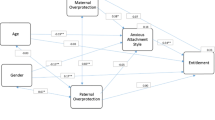Abstract
871 participants, 375 boys and 496 girls, mean age 16.7 + 1, were administered the Parental Bonding Instrument (P.B.I.), the Brief Symptom Inventory (B.S.I.), the General Well-Being Questionnaire (G.W.B.) and the Chestnut Lodge Transitional Object Scale. Results supported Winnicott's theory: participants reporting attachment to a Transitional Object (T.O.) in their childhood reported significantly more optimal maternal bonding than participants who were not attached to a T.O. Participants reporting attachment to a T.O. in adolescence had significantly more psychiatric symptoms and less general well-being. Adolescence T.O. attachment might be considered a marker of mental distress in the general, normal population.
Similar content being viewed by others
References
Winnicott DW: (1951) Transitional objects and transitional phenomena. Through Pediatrics to Psychoanalysis. London: Hogarth Press, 1982.
Mahler M: On the first three subphases of the separation—individuation process. International J of Psychoanal 53:333–338, 1972.
Mahler M, Pine F, Bergman A: The Psychological Birth of the Human Infant: Symbiosis and individuation. New York: International University Press, 1975.
Triebenbacher SL, Tegano DW: Children's use of transitional objects during daily separations from significant caregivers. Perceptual and Motor Skills 76(1):89–90, 1993.
Provence S, Lipton RC: Infants in Institutions. A Comparison of Their Development with Family-Reared Infants During the First Years of Life. New York: International University Press, Inc, o1962.
Lehman EB, Denham SA, Moser MH, Reeves SL: Soft object and pacifier attachments in young children: The role of security of attachment to the mother. J Child Psychology and Psychiat and Allied Disciplines 33(7):1205–1215, 1992.
Jonsson C, Taje M: “Good-enough” mothering and the incidence of transitional objects after infantile colic. J Am Acad of Child Psychiat 22:545–548, 1983.
Winnicott DW: (1962) Ego integration in child development. In: DW Winnicott, The Maturational Process and the Facilitating Environment. London: Hogarth Press, 1965.
Applegate JS: The transitional object reconsidered: Some sociocultural variations and their implications. Special Issue: Early childhood and clinical social work. Child and Adolescent Social Work J 6(1):38–51, 1989.
Wolf, AW, Lozoff B: Object attachment, thumbsucking, and the passage to sleep. J Am Acad of Child and Adolescent Psychiat 28(2):287–292, 1989.
Litt CJ: Theories of transitional object attachment: An overview. Int J Behav Developm 9(3):383–399, 1986.
Bush F: Theme and variation in the development of the first transitional object. Int J Psychoanal 58:479–486, 1977.
Parker G, Tupling H, Brown LB: A Parental Bonding Instrument. Brit J Med Psychol 52:1–10, 1979.
Parker G: The Parental Bonding Instrument. Social Psychiatry and Psychiatric Epidemiology 25:281–282, 1990.
Derogatis LR, Spencer PM: The Brief Symptom Inventory. Administration, scoring and procedures, Manual 1. Baltimore, MD: Clinical Psychometrics Research, 1982.
Dupuy DF: Utility of the National Center for Health Statistics' General Well Being Schedule in the assessment of self-representations of subjective well being and distress. Paper presented at the National Conference on the Evaluation of Drug, Alcohol and Mental Health Programs, 1975.
Free K: Prolonged attachment to transitional objects in a psychopathological adolescent population: Implications for development, assessment and treatment. Dissertation Thesis, University of Maryland 1985.
Bowlby J: A Secure Base: Parent-Child Attachment and Healthy Human Development. New York: Basic Books, 1988.
Boniface D, Graham P: The three-year-old and his attachment to a special soft object. J Child Psychol and Psychiat 201:217–224, 1979.
Newson J, Newson E, Mahalski P: Persistent infant comfort habits and their sequelae at 11 and 16 years. J Child Psychol and Psychiat 23:421–436, 1982.
Sherman M, Herzig M, Austrian R, Shapiro T: Treasured objects in school-aged children. Pediatrics 68:379–386, 1988.
Cohen KN, Clark JA: Transitional object attachments in early childhood and personality characteristics in later life. J Personality and Social Psychol 8:106–111, 1984.
Horton P, Lomy JW, Copollilo HP: Personality disorder and transitional relatedness. Arch Gen Psychiat 30:618–622, 1974.
Lobel L: A study of transitional objects in early histories of borderline adolescents. Adolescent Psychiatry 9:199–213, 1981.
Morris H, Gunderson JG, Zanarini MC: Transitional object use and borderline psychopathology. A J Psychiat 143(12):1534–1538, 1986.
Free K, Goodrich W: Transitional object attachment in normal and in chronically disturbed adolescents. Child Psychiat Hum Developm 16(1):30–44, 1985.
Ritva E: Transitional object and children with chronic disease: Comparative study of the forms of transitional object among children with diabetes mellitus or rheumatic disease. Psychotherapy and Psychosomatics 56(1–2):94–97, 1991.
Author information
Authors and Affiliations
Rights and permissions
About this article
Cite this article
Bachar, E., Canetti, L., Galilee-Weisstub, E. et al. Childhood vs. Adolescence Transitional Object Attachment, and Its Relation to Mental Health and Parental Bonding. Child Psychiatry Hum Dev 28, 149–167 (1998). https://doi.org/10.1023/A:1022881726177
Issue Date:
DOI: https://doi.org/10.1023/A:1022881726177




